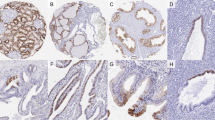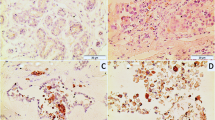Abstract
Restricted expression of oncofetal fibronectin mRNA in the tissues of thyroid papillary and anaplastic carcinoma has recently been shown by both Northern blot analysis and reverse transcriptase polymerase chain reaction (RT-PCR). Oncofetal fibronectin mRNA can be a target of gene diagnosis and targeted gene therapy, provided it is expressed in all cancer cells in the tissues. To investigate this criterion in thyroid cancer tissues, we measured their expression of oncofetal fibronectin mRNA using in situ hybridization. An abundant expression of oncofetal fibronectin mRNA was found in all the observed cancer cells of six papillary carcinomas and an anaplastic carcinoma, but not in the tissues of normal thyroid, Graves' disease, adenomatous goitre, follicular adenoma, follicular carcinoma or medullary carcinoma. This result encourages us to establish gene diagnosis of thyroid papillary and anaplastic carcinomas by detecting oncofetal fibronectin mRNA in biopsies.
This is a preview of subscription content, access via your institution
Access options
Subscribe to this journal
Receive 24 print issues and online access
$259.00 per year
only $10.79 per issue
Buy this article
- Purchase on Springer Link
- Instant access to full article PDF
Prices may be subject to local taxes which are calculated during checkout
Similar content being viewed by others
Author information
Authors and Affiliations
Rights and permissions
About this article
Cite this article
Takano, T., Matsuzuka, F., Miyauchi, A. et al. Restricted expression of oncofetal fibronectin mRNA in thyroid papillary and anaplastic carcinoma: an in situ hybridization study. Br J Cancer 78, 221–224 (1998). https://doi.org/10.1038/bjc.1998.468
Issue Date:
DOI: https://doi.org/10.1038/bjc.1998.468
This article is cited by
-
High-throughput differential screening of mRNAs by serial analysis of gene expression: decreased expression of trefoil factor 3 mRNA in thyroid follicular carcinomas
British Journal of Cancer (2004)
-
NATH, a novel gene overexpressed in papillary thyroid carcinomas
Oncogene (2002)
-
Analysis of splice variants of the fibronectin gene in thyroid carcinomas by reverse transcription-polymerase chain reaction: Increased expression of oncofetal fibronectin mRNA in papillary carcinomas is not caused by the alternation in splicing
Journal of Endocrinological Investigation (1999)



